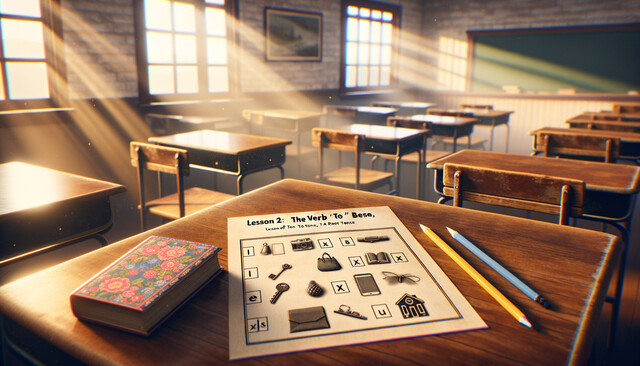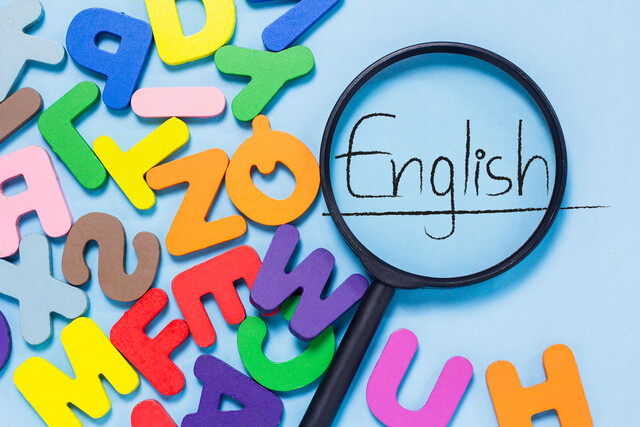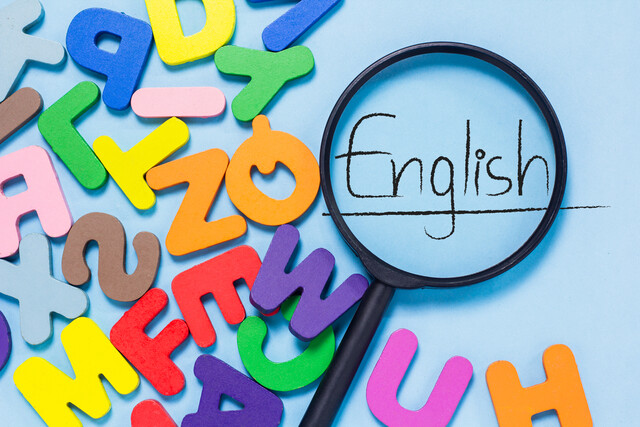If you do use a textbook (and most teachers do), the lesson plans give you examples of how to teach grammar and techniques for teaching that can be used with your textbook. If you teach without a textbook, they can be followed directly as is.
The target language of the usage "to be" in the simple present is geared towards beginners, but even higher-level students sometimes have bad habits that need correction. They still make the mistake of "they is" because they have said it thousands of times before. They get lost in the moment of speaking English and don't hear themselves making the mistake, and they do it over and over, even after correction.
That's why the Practice stage of this English lesson, and all the lessons, is important. Repetition out loud can start to break a bad habit, and for beginners it will get them on the right track from the beginning so none of them become one of those English learners with bad habits.
A technique for teaching contractions
Beginners sometimes find contractions a challenge.
The good news is that most of them will understand the use of "I'm" as the contraction of "I am," since they will have heard it before and maybe even used it without knowing what exactly they were doing. So once they come to understand "I'm," the other basic contractions become more understandable and easier for them to learn and for you to teach.
And after that, the concept of contractions will be embedded in their minds and so contractions such as don't, won't, should've (and someday even shouldn't've) also can be more easily taught and learned.
Here's a tip that is both helpful for students as well as a kind of fun way to demonstrate contractions.
When introducing any and all contractions, try to visually demonstrate the idea of the squashing the words together.
For example, let's say you are teaching to be in the simple present, and now you are on "you are" and "you're."
Point to "you are" and say it, getting the class to repeat. Now indicate "you are" again but with two hand cupped like parenthesis around the two words; say "you are" again. Then move your hands closer together like you are squashing the words together, and move your hands over to "you're" on the board, saying "you're!" when you get there. Do this every time for each contraction you are presenting on the board.
Another tip is to show somewhat mathematically the combining of the words:
you + are = you're
You can also do this another way. Write the words closer together with the plus sign like this:
Say "you are." Then erase the "+" and the "a" and draw in the apostrophe, leaving:
you're
Now say "you're!" (with the emphasis to show the new word formed.)
In a classroom lesson when you are presenting contractions to students already familiar with the concept, it's good to occasionally remind them anyway.
For example, let's say you have written a sentence of the board like "She's a fan of football, but he doesn't like it." You can point to the apostrophe and say "what is it?" or "why is it here?"
Students will generally offer an answer by just saying the two uncontracted words ("she is" or "does not"). Whatever they offer during this momentary mini-quiz is fine as long as it confirms their understanding of the concept.
A technique for indicating points of view
This is a technique for indicating points of view (first person, second person etc.) in both singular and plural forms.
Point to I am, say and have the students repeat "I am," then say "I am happy" while pointing to yourself. Repeat for "I'm" to show the contraction. Then indicate one student for "you are," and "you are happy" and "you're happy."
Indicate one student and then address the rest of the class to present "he is happy." Do again with a female student for "she is happy." For "it is happy" you could draw a photo of a dog next to the words on the board.
For "we are" you can swirl your hand around to indicate the class and yourself included.
For the first person plural, indicate the whole class and say "you all are happy," or by indicating several students one at a time and say "you and you and you and you all are happy. You are happy."
To show "they are happy," indicate with an open hand one side of the class, then point in the same direction as your open hand while you look at the rest of the class and say "they are happy."
This same technique can be repeated quickly as you go through the negative forms and finally with the question forms.
With the question forms, also point out that the question is formed by reversing the order of the affirmative form, for example "we are" and "are we?" When you get to the question forms, you can the two words of the affirmative ("we are,") one hand for each word, and then show how they switch places by switching the places of your hands and you indicate "are we?"
This technique can be used in following classes when the students are still grasping the concepts of pronouns (I, you, we etc.)
Lesson Plan
So let's look the target language (classroom objectives) of this lesson plan:
-Learning the verb "to be" in the present simple
-Text comprehension with the present simple with "to be."
-Asking and answering questions with "to be"
-Vocabulary: a doctor, a teacher, an office worker, a computer programmer, a secretary, a pilot
Presentation (eliciting in context)
The vocabulary for this classroom lesson includes words for jobs.
In Lesson 1 we studied the teaching technique called eliciting, which is when the teacher tries to draw out of the students the knowledge that they already know, so the teacher can build on it. We don't just give students the words in advance, so at the beginning of the lesson the words are not on the board.
So in this class with this target language, you would point to an image of (or draw) a doctor and ask "What is it?" Or you might say, "When we go to the hospital, we talk to a.?" Usually someone will know the word doctor. Encourage all replies, and affirm the correct answer by repeating "a doctor."
If no one knows the word, present it to them by saying "a doctor." Either way, you go to the board and write "a doctor" next to the image.
Then again say aloud "a doctor," and get the students to repeat, first together, and then individually, in the way we covered in the Lesson 1.
Do the same for all the vocabulary words. However, when you come to "an office worker," underline the "an" and point to the "o" in "office worker." Emphasize the pronunciation. It's necessary to show it briefly now so students will use it correctly during this classroom lesson. This also serves as a small introduction to "a" versus "an" which would be covered more specifically in later lessons.
When you are done with the verbal repetitions, have the students write the words in their notebooks. You can say simply "Open your books. Please write" in the way we covered in Lesson 1.
You will notice that some students write exactly what you have on the board, and that's all. Some will draw the images next to the vocabulary words. Some will write a translation for themselves in their native language. These notes of theirs are for their own study later, and all of it is fine as long as they are correctly writing the vocabulary words.
When you are done, the students will have been drilled in the meaning of the words. Now it is time for a mini-test.
Say (and demonstrate if necessary) "close your books."
Then go to the board and erase the vocabulary words, leaving only the images. Go to each image, point, and elicit a response. If you have thoroughly conducted this presentation of the vocabulary, they will all be able to quickly identify each image.
Next you present the grammar part of the target language. In this case there's a lot of writing to be done, so you should write it down before class. As you can see below, the essential parts should be underlined (or in different colors if you have different color pens or chalk).
TO BE
I am I'm
You are You're
He is He's
She is She's
It is It's
We are We're
You are You're
They are They're
No,
I am not I 'm not
You are not You're not / You aren't
He is not He isn't / He's not
She is not She isn't / She's not
It is not It isn't / It's not
We are not We aren't / we're not
You are not You aren't / you're not
They are not They aren't / they're not
Am I ?
Are you?
Is he?
Is she?
Is it?
Are we?
Are you?
Are they?
After this, you would go through all the verb forms on the board, having your student repeat them out loud and using the technique above on contractions.
Note: All forms of "to be" in the present simple are presented, as they should be. However, not all forms are used in the Production activities later. For example, in the Production students ask "Are you.?" but not "Is she.?" That's because this is a beginner classroom lesson introducing this grammar. The next classroom lesson would follow up on this grammar and the students would learn to use "Is she.?" etc.
It's a rule of thumb that good classroom lessons always include some practice in questions, answers and negative answers of any tense that is being covered.
Practice
As we have covered in the previous lesson, the practice can take various forms.
In this case, the quiz would be a handout with something like this below, which you would hold up and the use to point out the example with the answer provided, reading it aloud. You could also quickly write the example on the board with the blank, and show them how they should fill in the blank.
If it's an exercise in the book, you would hold up the book, open to the page with the exercise, and say (for example) "Open your book, page 10, exercise 4."
Then say "4 minutes" or some appropriate time that encourages them to work steadily on the exercise.
TO BE
Example
I _____ a computer programmer.
I am a computer programmer.
They ______________ doctors. (NEGATIVE)
They are not / aren't doctors.
Note: An alternative which you can use and might be included in your textbook is to present the negative in the exercise like this:
No, they ______________ doctors.
No, they are not / aren't doctors.
1. He ______ a doctor.
2. They ______ teachers. (NEGATIVE)
3. We ______ are doctors.
4. Mary ______ a pilot.
5. She _____________ from London. (NEGATIVE)
6. They _______ computer programmers.
7. We ______ secretaries.
8. She ______________ a secretary. (NEGATIVE)
During the exercise, go around and monitor the students, sometimes offering words of encouragement, and prompting self-correction when you see a mistake.
After, quickly call for the answers. You can call on one student at a time and say "Number 1?" etc.
Then present practice 2 and monitor etc. in the same way as practice 1:
Practice 2 : Questions? - Fill in the blank
Example
______ she a computer programmer?
___Is__ she a computer programmer?
1. ________ he a doctor?
2. ________ they teachers?
3. ________ she a computer programmer?
4. ________ they doctors?
7. ________ you a pilot?
8. ________ she a pilot?
9. ________ you an office worker?
Now present practice 3 the same way:
Practice 3
Fill in the blanks.
Hello, my name __________ John Smith. __________ from California, and ___________ a computer programmer for Microsoft. My wife ________________ American. She _________ from France and her name _____________ Clare. No, she __________ a computer programmer. She __________ a teacher in a school.
Production
An introduction to the Production could be just having the students read the final, completed text of practice 3. As mentioned in a Lesson 1, it's good to keep your students alert by randomly picking the next student to read a line, instead of just going around the class in order.
You could skip this exercise and start the Production by giving the students a few minutes to write an introduction like Practice 3 about themselves. If they are not married, they can write about family members.
Then put them into closed pairs and let them introduce themselves to each other. You could also make this a free-for-all class activity where everyone stands up goes around the room introducing themselves to each other.
This activity, which goes to the main classroom objective, might serve as enough for the whole Production.
If not (for example, if there is more time left in class), here is another Production activity:
Use index cards with different names, places, jobs etc. like this:
Pablo Matsomoto
Dallas, Texas, USA
Office worker at American Airlines
From Mexico
Wife: Kathy Matsomoto, American, pilot for American Airlines.
Hold up index card. Model the exercise by indicating each line on the card and saying "I'm Pablo Matsomoto. I'm from Dallas, Texas. I am an assistant at American Airlines. I'm from Mexico. My wife is Kathy Matsomoto."
Then you could put the students in pairs and give each pair the cards, having them take turns introducing themselves based on the info in the cards for the rest of the class.
Another exercise is to have the students practice simple questions and answers.
Use one student to help you model. Write "Are you a pilot?" on the board. Have the student ask you, and then look at your card and say (for example) "No, I'm not a pilot, I'm an office worker."
Then have the student ask again, and this time look at the appropriate card and say "Yes, I'm a pilot." Have the students ask each other in their pairs "Are you a pilot" and to answer based on their cards.
Another idea is to save for last (or repeat again at the end) the exercise where the students actually introduce themselves. With five minutes (or whatever is appropriate based on the class size), you could have all the students stand and introduce themselves one at a time. That way you end with each student in the real-life exercise.
A good teacher always has a few alternative exercises ready for the Production phase in case the students finish with time left in the class.

























